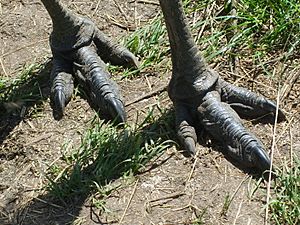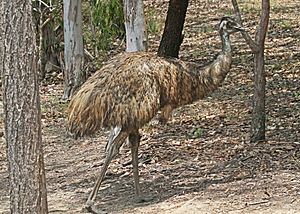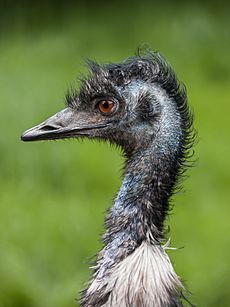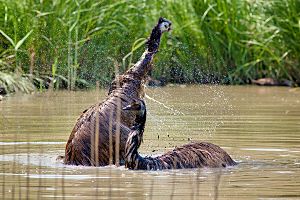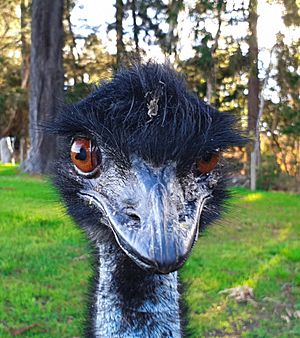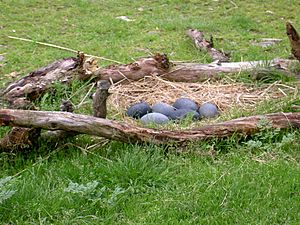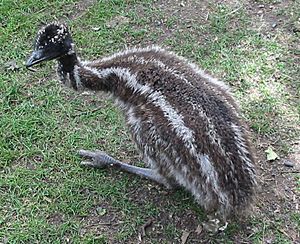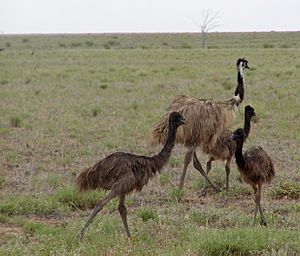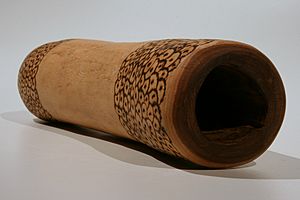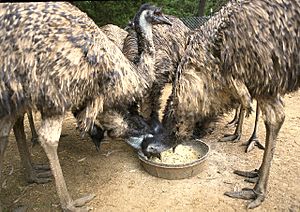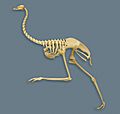Emu facts for kids
Quick facts for kids Emu |
|
|---|---|
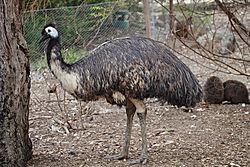 |
|
| Scientific classification | |
| Kingdom: | |
| Phylum: | |
| Class: | |
| Order: | |
| Family: |
Casuariidae
|
| Genus: |
Dromaius
|
| Binomial name | |
| Dromaius novaehollandiae (Latham, 1790)
|
|
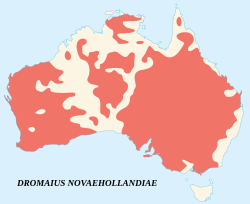 |
|
| The Emu has been recorded in the areas shown in pink. | |
The Emu, known scientifically as Dromaius novaehollandiae, is a very large flightless bird. It lives naturally in Australia. The emu is the tallest bird in Australia. It is also the second tallest bird in the world, right after its relative, the ostrich. Emus are also related to the cassowary, which is a bit smaller but heavier.
Contents
Emu Appearance and Features
The emu is the second tallest bird in the world. Only the ostrich is taller. Large emus can stand up to 150 to 190 cm (59 to 75 in) tall. From beak to tail, emus are usually 139 to 164 cm (55 to 65 in) long. Males average 148.5 cm (58.5 in) and females average 156.8 cm (61.7 in). Emus weigh between 18 and 60 kg (40 and 132 lb). Females are often a bit larger and wider than males.
Even though emus cannot fly, they have tiny wings. These wings are about 20 cm (8 in) long and have a small claw at the tip. Emus flap their wings when they run. This might help them stay balanced when moving quickly. They have long necks and legs. Emus can run very fast, up to 48 km/h (30 mph). Their legs are very strong and built for running. Their feet have only three toes. The ostrich, for example, has two toes. Emus are the only birds with certain muscles in the back of their lower legs. When walking, an emu's steps are about 100 cm (3.3 ft) long. When running fast, a single stride can be as long as 275 cm (9 ft). Their legs have no feathers, and their feet have thick, soft pads. Like the cassowary, emus have sharp claws on their toes. These claws are their main way to defend themselves. They use their claws to kick and hurt opponents. The toe and claw together can be 15 cm (6 in) long. Their beak is small, about 5.6 to 6.7 cm (2.2 to 2.6 in) long, and soft. It is good for eating plants. Emus have good eyesight and hearing. This helps them spot dangers from far away.
An emu's neck is pale blue, and you can see it through its thin feathers. Their body feathers are grey-brown and look shaggy. The tips of their feathers are black. These black tips soak up sunlight, but the inner plumage keeps their skin cool. This helps emus stay active even on hot days. A special thing about emu feathers is that each feather has two shafts coming from one base. Both parts are the same length. The feathers near the skin are soft and furry, but the ends look like grass. Male and female emus look similar. Their feather color can change a bit depending on where they live. This helps them camouflage themselves. For example, emus in dry, red areas have a reddish tint. Young emus, about three months old, have blackish feathers with fine brown stripes. Their head and neck are especially dark. As they grow, the feathers on their face thin out, showing their bluish skin. They get their adult feathers when they are about fifteen months old.
Emus have special clear eyelids called nictitating membranes. These eyelids move sideways across their eyes. They act like goggles to protect their eyes from dust in windy, dry places. Emus also have a throat pouch, which gets bigger during mating season. This pouch is quite large, over 30 cm (12 in) long.
Where Emus Live: Distribution and Habitat
Emus used to be common on Australia's east coast, but now they are rare there. However, farming and water sources in the middle of Australia have helped emus spread into dry areas. Emus live in many different places across Australia, both inland and near the coast. They are most often found in savannah woodlands and forests. They are less common in busy cities or very dry places with little rain. Emus usually travel in pairs. Sometimes they form large groups, but this is usually when they need to find new food. Emus can travel long distances to find good feeding spots. In Western Australia, emus move north in summer and south in winter. On the east coast, their movements seem more random.
Emu Behavior and Daily Life
Emus are diurnal, meaning they are active during the day. They spend their days looking for food, cleaning their feathers with their beaks, taking dust baths, and resting. They usually live in groups, except during breeding season. When in a group, some emus look for food while others watch for danger. They can swim if they need to, but they usually only do this if an area is flooded or they need to cross a river.
Emus start to settle down at sunset and sleep at night. They do not sleep all the time. They wake up several times during the night. When they start to fall asleep, they first squat down. They stay alert enough to react quickly if something disturbs them. As they fall into a deeper sleep, their neck drops closer to their body, and their eyelids close. If it is quiet, they fall into a deep sleep after about twenty minutes. During this deep sleep, their body lowers to the ground with their legs folded. Their beak is turned down, and their neck forms an S-shape, folded onto itself. Their feathers help direct any rain away from their body. Some people think their sleeping position helps them blend in, looking like a small mound. Emus usually wake up from deep sleep every ninety minutes or so. They stand up to eat a little or go to the bathroom. This awake time lasts for ten to twenty minutes, then they go back to sleep. Overall, an emu sleeps for about seven hours every day. Young emus usually sleep with their neck flat and stretched out on the ground.
Emus make different sounds, mostly booming and grunting. The booming sound comes from their inflatable throat pouch. They can change the sound's pitch. Most of the booming sounds are made by females.
On very hot days, emus pant to stay cool. Their lungs act like coolers, helping water evaporate from their bodies. Unlike some other animals, this does not cause problems for their blood. For normal breathing in cooler weather, they have large, folded nasal passages. Cool air warms up as it goes into their lungs, taking heat from their nose area. When they breathe out, their cold nasal passages collect moisture from the air, which they can reuse. Emus are good at keeping their body temperature steady, even when the outside temperature is very cold (−5 °C (23 °F)) or very hot (45 °C (113 °F)). Their comfortable temperature range is between 10 and 30 °C (50 and 86 °F).
Emus have a lower basal metabolic rate than many other birds. This means they use less energy. When an emu is sitting down in cold weather, it uses about 60% less energy than when standing. This is partly because they do not have feathers under their stomach, so they lose more heat when standing.
What Emus Eat: Diet
Emus look for food during the day. They eat many different kinds of plants, both native and introduced. Their diet changes with the seasons. They like plants such as Acacia, Casuarina, and grasses. They also eat insects and other small creatures. These include grasshoppers, crickets, beetles, cockroaches, ladybirds, bogong moth larvae, ants, spiders, and millipedes. These provide a lot of the protein they need. In Western Australia, emus eat seeds from Acacia aneura until it rains. After rain, they eat fresh grass shoots and caterpillars. In winter, they eat leaves and pods from Cassia plants. In spring, they eat grasshoppers and the fruit of Santalum acuminatum. They are also known to eat wheat and other crops. They can even climb over tall fences to get to food. Emus help spread large seeds, which is important for plant diversity.
Emus in zoos have been known to eat strange things like glass, marbles, car keys, and jewelry.
Emus do not drink water very often, but when they do, they drink a lot. They usually drink once a day. They first check the water and the area around it in groups. Then they kneel down at the edge to drink. They prefer to drink on firm ground, not on rocks or mud. If they feel danger, they often stand up instead of kneeling. If not disturbed, they might drink for ten minutes straight. Because water sources can be scarce, emus sometimes have to go without water for several days. In the wild, they often share water holes with kangaroos and other animals. They are careful and usually wait for other animals to leave before they drink.
Emu Life Cycle and Reproduction
Emus form pairs for breeding in December and January. They might stay together for about five months. During this time, they stay in an area a few kilometers wide. Both males and females gain weight during breeding season. The female becomes a bit heavier, weighing between 45 and 58 kg (99 and 128 lb). Mating usually happens between April and June. The exact timing depends on the weather, as they nest during the coolest part of the year.
Males build a simple nest on the ground in a partly sheltered spot. They use bark, grass, sticks, and leaves to line it. The nest is usually flat, but in cold weather, it can be taller (up to 7 cm (2.8 in)) and more rounded to keep heat in. If other materials are not available, they might use a spiky spinifex tussock. The nest is usually placed where the emu can clearly see its surroundings to spot predators.
Female emus try to attract the males. The female's feathers get a bit darker. The small bare skin patches near her eyes and beak turn turquoise-blue. The male's feathers do not change color, but his bare skin patches also turn light blue. When courting, females walk around, pulling their neck back and puffing out their feathers. They make low, drumming sounds. This calling can happen even when males are out of sight or far away. Once a male notices her, the female circles him from 10 to 40 metres (30 to 130 ft) away. She looks at him by turning her neck, keeping her back towards him. If the male shows interest, he moves closer. The female keeps circling, moving a bit further away.
The pair mates every day or two. Every second or third day, the female lays one egg. A female lays a clutch of five to fifteen very large, thick-shelled, green eggs. The shell is about 1 mm (0.04 in) thick. The eggs are typically 13 cm × 9 cm (5.1 in × 3.5 in) and weigh between 450 and 650 g (1.0 and 1.4 lb). The female puts a lot of energy into each egg. The first known case of identical bird twins was found in an emu egg. The egg surface is bumpy and pale green. During incubation, the egg turns dark green. If it does not hatch, the sun can bleach it white.
The male emu becomes broody (wants to sit on eggs) after his mate starts laying. He might start sitting on the eggs before all of them are laid. From this time on, he does not eat, drink, or go to the bathroom. He only stands up to turn the eggs, about ten times a day. He develops a bare patch of skin on his belly that touches the eggs. During the eight-week incubation period, he will lose a third of his weight. He survives on stored body fat and any morning dew he can reach from the nest. Like many Australian birds, once the male starts sitting on the eggs, the female usually leaves. She might mate with other males and lay eggs in other nests. So, up to half the chicks in a nest might not be fathered by the male sitting on them. Sometimes, they are not even from either parent, as emus can lay eggs in other emu nests.
Some females stay and protect the nest until the chicks hatch. But most leave the nesting area completely to nest again. In a good season, a female emu might nest three times. If the parents stay together during incubation, they take turns guarding the eggs. The other parent drinks and eats nearby. If they sense danger, they lie down on the nest to blend in. If the danger comes too close, they suddenly stand up to scare it away.
Incubation takes 56 days. The male stops sitting on the eggs shortly before they hatch. The nest temperature rises a little during the eight weeks. Even though eggs are laid over time, they tend to hatch within two days of each other. This is because eggs laid later develop faster due to higher temperatures. Newly hatched chicks are active and can leave the nest within a few days. They are about 12 cm (5 in) tall at first and weigh 0.5 kg (17.6 oz). They have clear brown and cream stripes for camouflage, which fade after about three months. The male guards the growing chicks for up to seven months. He teaches them how to find food. Chicks grow very quickly and are fully grown in five to six months. They might stay with their family for another six months before leaving to breed in their second year. When they are young, the male protects them from other emus, including the mother. He does this by ruffling his feathers, making sharp grunts, and kicking his legs. He can also crouch over smaller chicks to protect them. At night, he covers his young with his feathers. Since young emus cannot travel far, parents must choose a nesting area with plenty of food. In captivity, emus can live for over ten years.
Emus and People
Indigenous Australians and early European settlers used emus for food. Emus are curious birds. They might come closer to humans if they see unexpected movement. In the wild, they might follow and watch people. Aboriginal Australians used different ways to catch emus. They would spear them at waterholes, catch them in nets, or attract them by making emu calls. They also used a ball of feathers and rags hung from a tree to get their curiosity. Sometimes, a poisonous plant was used to make a waterhole unsafe. The confused emus were then easy to catch. Another method was for a hunter to wear an animal skin as a disguise. The birds could be lured into a hidden pit trap using rags or fake calls. Aboriginal Australians only killed emus when necessary. They believed it was wrong to hunt them for any other reason. Every part of the emu carcass was used. The fat was used for its valuable oil, which had many uses. The bones were made into knives and tools. Feathers were used for body decoration. Tendons were used as string.
Early European settlers killed emus for food and used their fat to fuel lamps. They also tried to stop emus from damaging farms or entering settlements during dry periods to find water. A famous example of this was the Emu War in Western Australia in 1932. Emus gathered in an area during a dry spell, damaging fences and crops. The army was called in to shoot them with machine guns. However, the emus mostly avoided the hunters and won the "battle." Emus are large, strong birds. Their legs are among the strongest of any animal. They are powerful enough to tear down metal fences. Emus are very protective of their young. There have been two known cases of emus attacking humans.
Economic Value of Emus
In areas where it lived, the emu was an important food source for Aboriginal Australians. They used the fat as bush medicine and rubbed it on their skin. It was also a valuable lubricant and was used to oil wooden tools. It was mixed with ochre to make traditional paint for ceremonies.
Here is how the Arrernte of Central Australia cooked emus:
"Emus are around all the time, in green times and dry times. You pluck the feathers out first, then pull out the crop from the stomach, and put in the feathers you've pulled out, and then singe it on the fire. You wrap the milk guts that you've pulled out into something [such as] gum leaves and cook them. When you've got the fat off, you cut the meat up and cook it on fire made from river red gum wood."
Emus were a source of food and fuel for early European settlers. Today, emus are farmed in Australia and other countries. They are raised for their meat, oil, and leather. Commercial emu farming started in Western Australia around 1970. The industry in Australia uses emus bred in captivity. Most Australian states have rules to protect wild emus. Outside Australia, emus are farmed on a large scale in North America, Peru, and China. Emus breed well in captivity. They are kept in large open pens to prevent leg and digestion problems from not moving enough. They are usually fed grain and allowed to graze. They are typically ready for use at 15 to 18 months old.
Some people believe emu oil helps with inflammation. However, there have not been many scientific tests on humans. The oil is sold as a dietary supplement with many claimed health benefits. Emu leather has a special bumpy surface because of the feather spots on the skin. This leather is used for wallets, handbags, shoes, and clothes. Emu feathers and eggs are used in decorative arts and crafts. Empty emu eggs are often carved with pictures, like cameos, or scenes of Australian animals.
Emu Status and Conservation
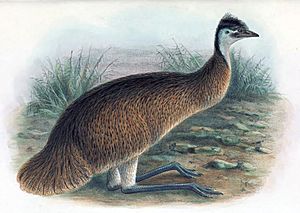
The number of emus on mainland Australia is thought to be higher now than before Europeans arrived. However, some local groups of emus are at risk of disappearing. Threats to emus include:
- Clearing and breaking up their natural homes.
- People deliberately killing them.
- Collisions with cars.
- Predators eating their eggs and young.
Images for kids
See also
 In Spanish: Emú común para niños
In Spanish: Emú común para niños


